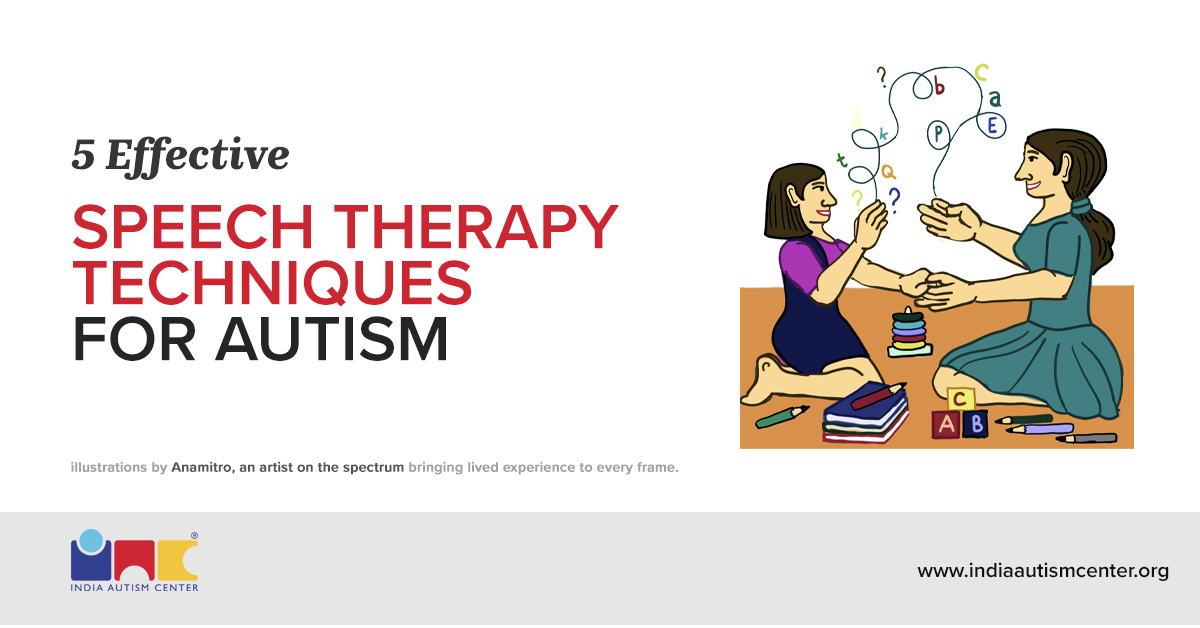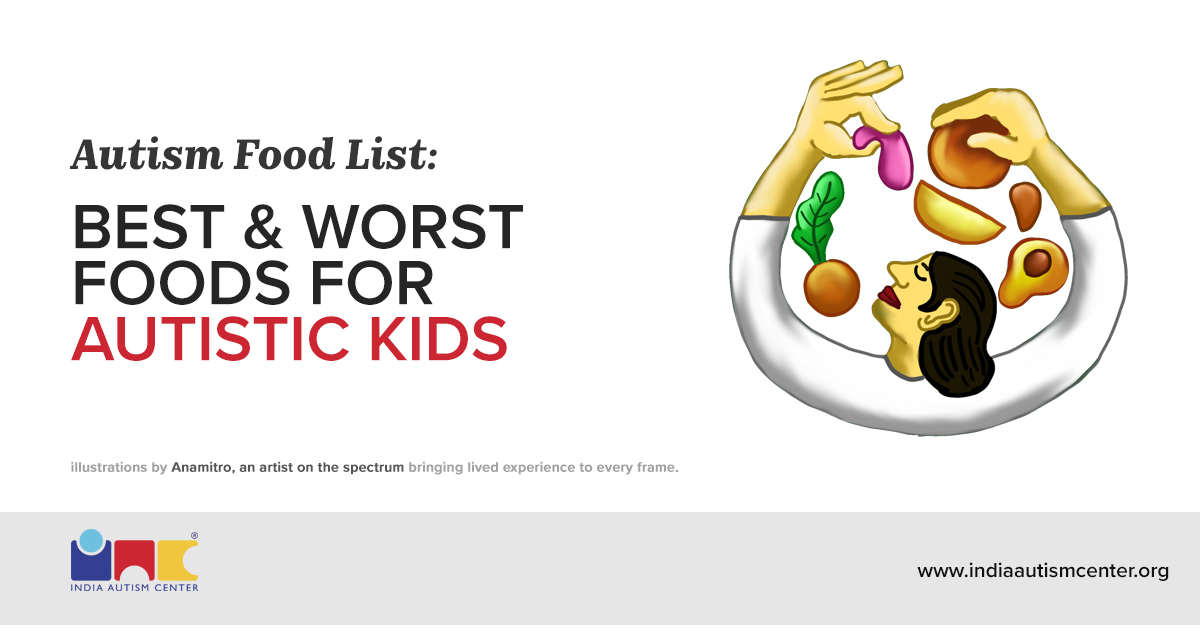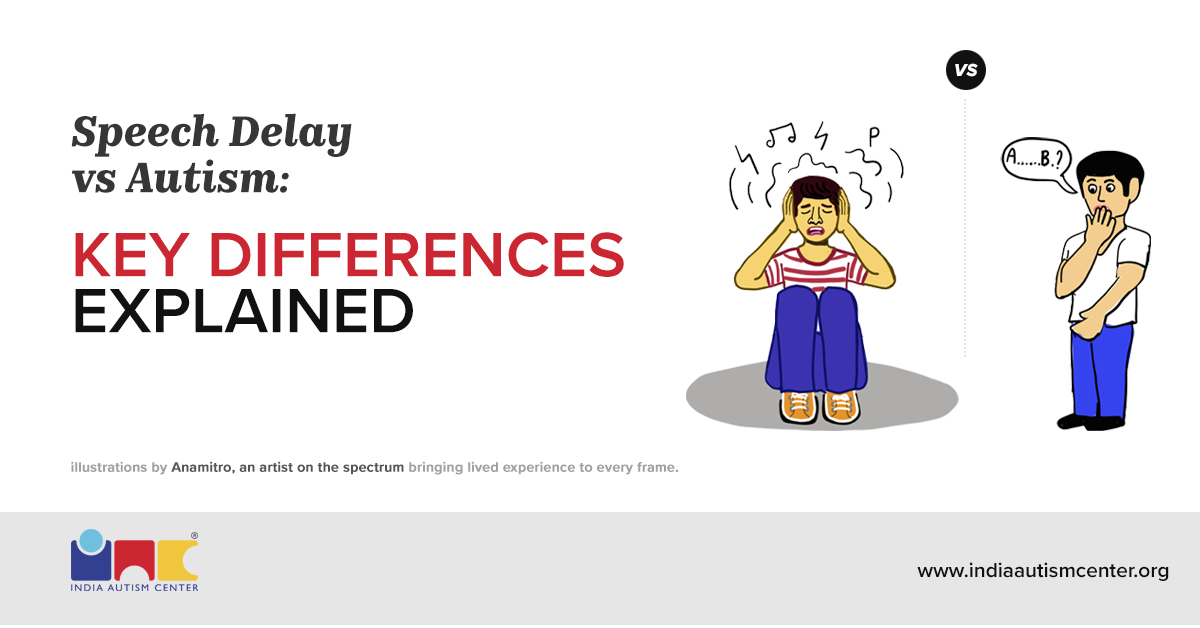For a parent who has a child on the autism spectrum, it can be challenging to help them communicate. It almost feels like a hidden language. Whether your child speaks in single words, uses gestures, or communicates nonverbally, remember there is always hope. You need to find the proper technique, and voila, your child can learn to express themselves.
In 2020, it was found that 1 in 36 children aged 8 years has ASD, and they have significant challenges when it comes to social communication and interactions. However, it can be managed and improved with early intervention for autism and correct speech therapy techniques for autism. Here, we present the five most effective speech therapy techniques for autism, along with autism-specific speech therapy activities that you can practise.
Understanding Communication Challenges in Autism

When it comes to processing language, it is different for children who are diagnosed with ASD. Some may have strong vocabularies but struggle with back-and-forth conversation, while others may communicate through gestures, pictures, or assistive devices.
However, here are the most common speech and language challenges that are prevalent in a child who has autism:
- Echolalia: It is when the child repeats words or phrases.
- Limited Vocabulary: The child speaks a limited number of words or has difficulty forming complete sentences.
- Flat Tone: There is intonation when they reach their peak; they may also exhibit unusual pitch.
- Difficulty Interpreting: Children with autism often struggle to interpret facial expressions or gestures.
- Challenges with Social Communication: They often struggle with taking turns in conversation.
The goal of speech therapy for autism isn’t just to teach words; it’s to build meaningful communication. This can involve speech, sign language, AAC devices, or even play-based learning.
Goals of Speech Therapy for Autism

Speech therapy for autism is not solely targeted at improving verbal communication; it is primarily designed to help individuals express themselves, connect with others, and navigate daily interactions with greater confidence.
The ultimate goal of autism speech therapy activities may differ from one child to another. However, they generally revolve around enhancing both communication skills and social understanding.
1. Encouraging Functional Communication
The primary goal of speech therapy for kids with autism is to help them communicate their needs, thoughts, and feelings effectively. It can be through words, gestures, signs, or augmentative and alternative communication devices.
2. Developing Social Communication Skills
Kids with autism often struggle with pragmatic language, which is the social use of language. Autism activities for speech therapy focus on teaching individuals how to take turns in conversation, understand expressions and tone, maintain eye contact, and use appropriate greetings and introductions.
3. Enhancing Understanding and Comprehension
Speech therapy techniques for autism target not only how a child speaks but also how they understand language. Speech therapists work towards improving the receptive language with the help of autism speech therapy activities. It helps children follow directions, recognise emotions in others, and understand stories or everyday situations.
4. Improving Articulation and Clarity
Some children with ASD speak but have difficulty pronouncing words clearly. Several speech therapy techniques for autism utilise articulation exercises, oral-motor activities, and repetition techniques to enhance clarity and fluency, thereby enabling others to understand them more effectively.
5. Supporting Emotional Expression and Regulation
Speech therapy is quite effective when it comes to emotional development. Therapists help children label their feelings (“I’m angry”, “I’m scared”) and use words instead of behaviours to express frustration. It helps reduce meltdowns and improve self-control.
6. Promoting Independence and Confidence
To communicate independently in real-life situations, speech therapy can prove to be quite helpful for children diagnosed with ASD. As they learn to express themselves clearly and understand others, their confidence grows, leading to better relationships and greater participation in school and community activities.
5 Effective Speech Therapy Techniques for Autism
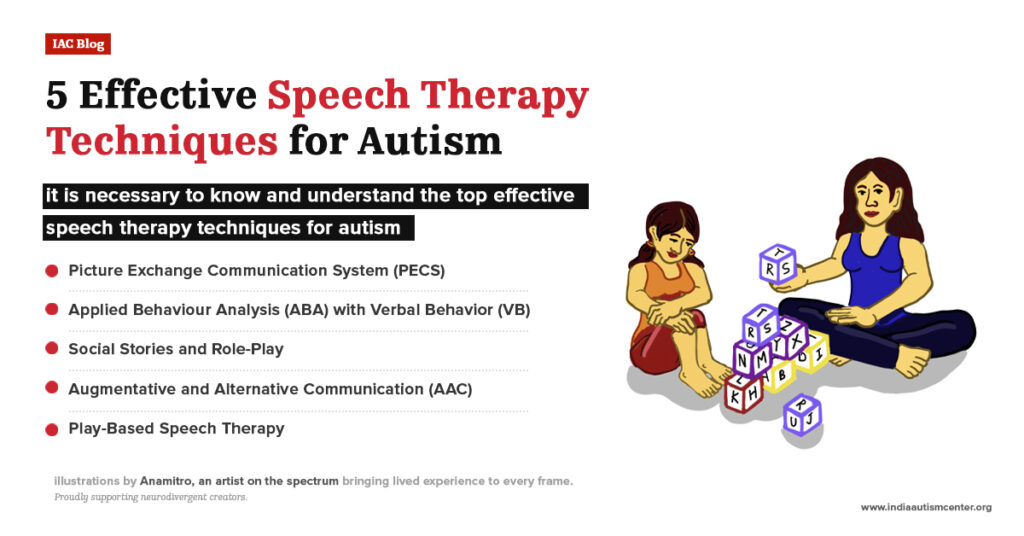
Communication is a key challenge when it comes to supporting children with autism. Nonetheless, it is one of the most rewarding areas of progress. Yet, early invention is known to have a significant impact.
It can improve both verbal and non-verbal communication skills, enhancing overall social interaction and independence.
So if you are a caregiver, parent, or therapist, it is necessary to know and understand the top effective speech therapy techniques for autism that help you to make the life of a child with ASD meaningful.
Here are the top techniques:
1. Picture Exchange Communication System (PECS)
The Picture Exchange Communication System (PECS) is one of the most widely used and effective speech therapy techniques for kids with Autism Spectrum Disorder. According to this technique, communication occurs through pictures before developing verbal language.
How this technique works:
The different stages in this structure include:
- Physical exchange: Child gives a picture to request an item.
- Increasing spontaneity: They learn to seek out communication partners.
- Discrimination training: Choosing between pictures for different items.
- Sentence structure: Using sentence strips like “I want + picture.”
- Answering questions: Responding to “What do you want?”
- Commenting: Describing surroundings, like “I see a cat.”
The benefits of this technique include:
- Encourages initiation of communication.
- Reduces frustration caused by speech delay.
- Builds a foundation for verbal development.
2. Applied Behaviour Analysis (ABA) with Verbal Behavior (VB)
The role of Applied Behaviour Analysis (ABA) in autism is the most evidence-backed. When combined with Verbal Behaviour (VB), it becomes a core communication building tool.
Here is how this approach works:
The approach has four functions:
- Mands (Requests): Asking for what they need. It serves as the starting point, as it motivates the individual to communicate.
- Tacts (Labels): Naming or identifying objects. It will help the child to share their experiences while enhancing their vocabulary.
- Echoics (Imitation): Repeating words or phrases. The child can learn new words, sounds and articulation.
- Intraverbals (Conversational Responses): Responding to others’ speech. It will help a child with autism to develop conversational skills and social interaction.
To encourage the attempts made by the child, therapists can use positive reinforcements.
The benefits of this technique include:
- Improves both expressive and receptive language.
- Encourages functional, purposeful communication.
- Helps children generalise language use in everyday situations.
In fact, more than 89% of studies have found positive results for children undergoing Applied Behaviour Analysis (ABA).
3. Social Stories and Role-Play
Social stories are a technique developed by Carol Grey. It includes powerful autism speech therapy activities that teach real-life social communication through storytelling.
How this approach works for children with autism:
- Short, personalised stories can be created to describe daily events, either by the therapist or by the parents. It includes greetings, waiting for their own turn, or interacting with other children while playing.
- Stories include images, predictable language, and positive cues.
- Role-playing stories are another option that allows children to practise their conversational skills.
The benefits of this technique include:
- Helps children interpret social cues and emotions.
- Builds vocabulary for real-life interactions.
- Improves narrative and conversational structure.
4. Augmentative and Alternative Communication (AAC)
AAC tools offer non-verbal individuals powerful ways to communicate, ranging from low-tech visuals to advanced speech-generating devices. The different types of AAC systems include the following:
Unaided AAC
It relies on the child’s body for communication:
- Gestures and signs (like pointing, waving, or signing “more”)
- Facial expressions
- Eye gaze or body language
This system is introduced in the early stages of therapy as part of autism speech therapy activities.
Aided AAC
Aided AAC involves external tools or devices. Depending on a child’s needs, these can include:
The benefits of this technique include:
- It encourages early communication in a child with autism. Helps to achieve significant milestones.
- AAC reduces the frustration that a child with autism faces due to the inability to express needs.
- AAC also helps in enhancing language development.
- AAC empowers children to communicate independently in school, therapy sessions, and social settings.
5. Play-Based Speech Therapy
This is one of the best ways for children to learn. Play-based speech therapy turns every interaction into a language opportunity. Unlike traditional methods that focus solely on verbal drills, play-based sessions encourage children to learn through experience, interaction, and imagination.
Autism activities for speech therapy, as per this approach, include prompts for speech, such as:
- Pretend Play: Cooking, doctor, and shopping scenarios.
- Music and Movement: Songs that teach rhythm and repetition.
- Sensory Play: Textures, sand, or water games.
The benefits of this technique include:
- This approach encourages spontaneous language in natural settings.
- It enhances joint attention and turn-taking.
- Builds confidence and creativity.
Autism Speech Therapy Activities to Try at Home

Even everyday activities at home can be powerful learning tools. Simple autism activities for speech therapy, such as reading, singing, or playtime, can help your child develop communication, comprehension, and social skills in a fun and natural way.
Here are the activities, their objective, how to conduct them, and what skills they develop:
| Activity | Objective | Example / How to Do It | Skills Developed |
| Morning Routine Conversations | Build sequencing and functional vocabulary | Narrate actions during dressing and brushing: “Shirt on! Pants on!” | Receptive language, daily communication |
| Storytime Reading | Improve comprehension and emotional recognition | Read picture books aloud, pause to ask questions (“Who is this?” “How does he feel?”) | Vocabulary, joint attention, emotional understanding |
| Music and Singing Games | Encourage imitation and sound production | Sing action songs like “If You’re Happy and You Know It” | Auditory processing, expressive speech, rhythm |
| Imitation & Play Games | Strengthen turn-taking and imitation | Copy gestures or sounds, play rolling ball or “Peek-a-Boo” | Imitation, turn-taking, joint attention |
| Snack Time Choices | Teach requesting and decision-making | Offer snack options: “Do you want an apple or a banana?” | Expressive communication, AAC use |
| Emotion Labeling | Develop emotional language and empathy | Label emotions: “You’re happy.” “You’re angry.” | Self-expression, social awareness |
| PECS & Visual Schedules | Support communication for nonverbal children | Use picture cards to request or make choices | Visual association, functional communication |
| Role-Play Conversations | Practice real-life social interaction | Pretend to order food or greet someone: “Hello! I want pizza.” | Pragmatic language, conversation flow |
| Outdoor Exploration | Link sensory experiences with language | Name things during walks — “Tree”, “Bird”, “Car” | Observation, descriptive vocabulary |
| Speech Therapy Apps / AAC Tools | Reinforce speech and vocabulary with technology | Use apps like Proloquo2Go or Speech Blubs | AAC development, word recall, and pronunciation |
The Power of Early Intervention
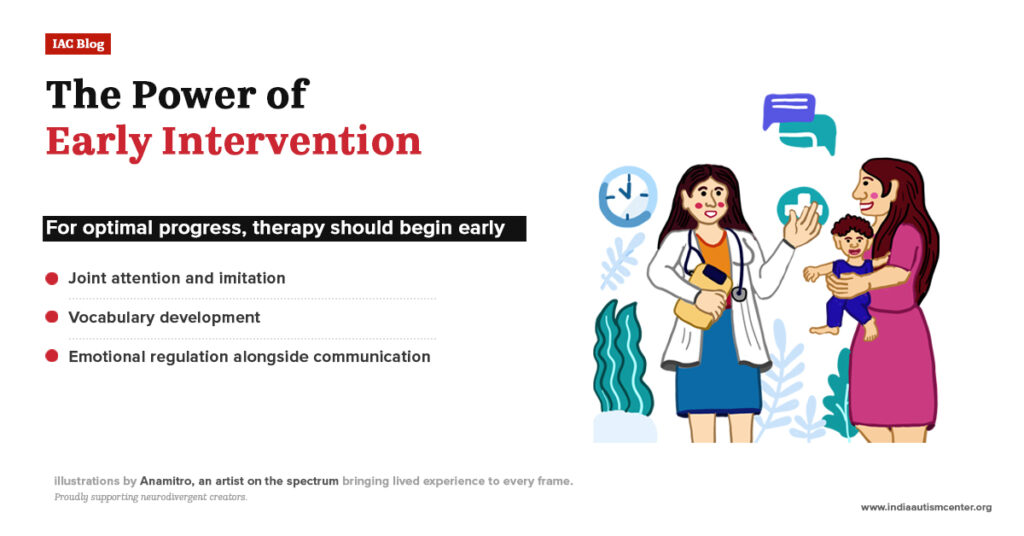
For optimal progress, therapy should begin early. Children who receive speech therapy before the age of 3 have a better chance of developing functional communication than those who start at a later stage. Early programmes focus on:
- Joint attention and imitation.
- Vocabulary development.
- Emotional regulation alongside communication.
Choosing the Right Speech Therapist
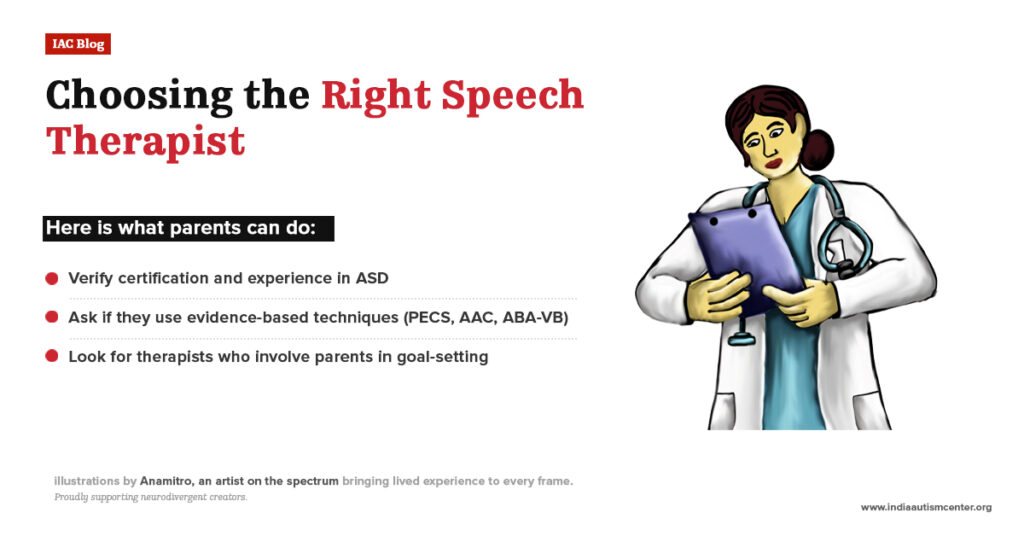
The key to your child’s progress is choosing the right speech therapist for autism. A good therapist will personalise sessions, involve parents in the process, and set realistic, measurable goals tailored to your child’s needs.
Here is what parents can do:
- Verify certification and experience in ASD.
- Ask if they use evidence-based techniques (PECS, AAC, ABA-VB).
- Look for therapists who involve parents in goal-setting.
Measuring Progress: Small Wins, Big Impact
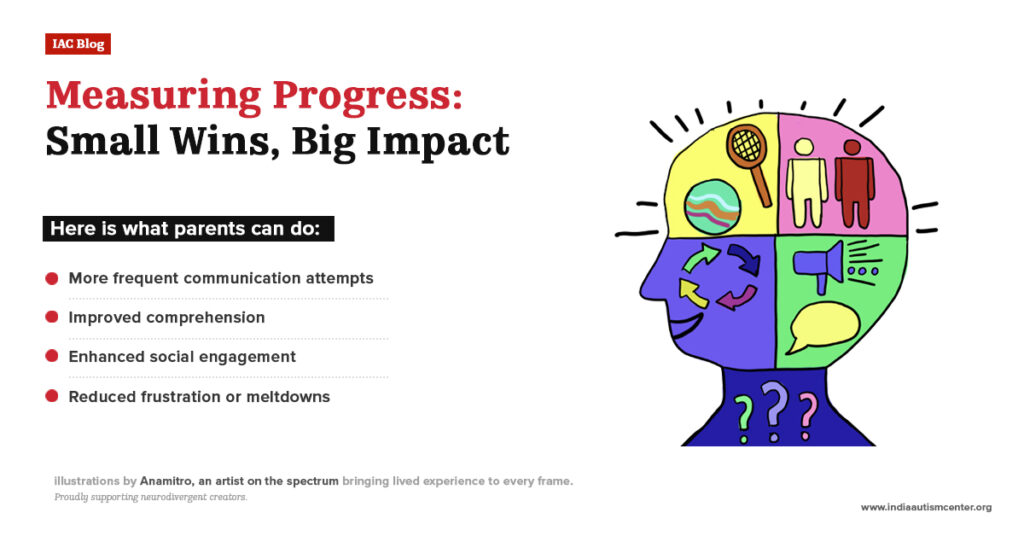
A large part of the progress is also measuring it so that gaps can be identified and filled if any exist. Progress for children with ASD can be measured through:
- More frequent communication attempts.
- Improved comprehension.
- Enhanced social engagement.
- Reduced frustration or meltdowns.
Besides, parents can also join support groups. It is also important to celebrate every milestone and seek emotional counselling if required.
Conclusion
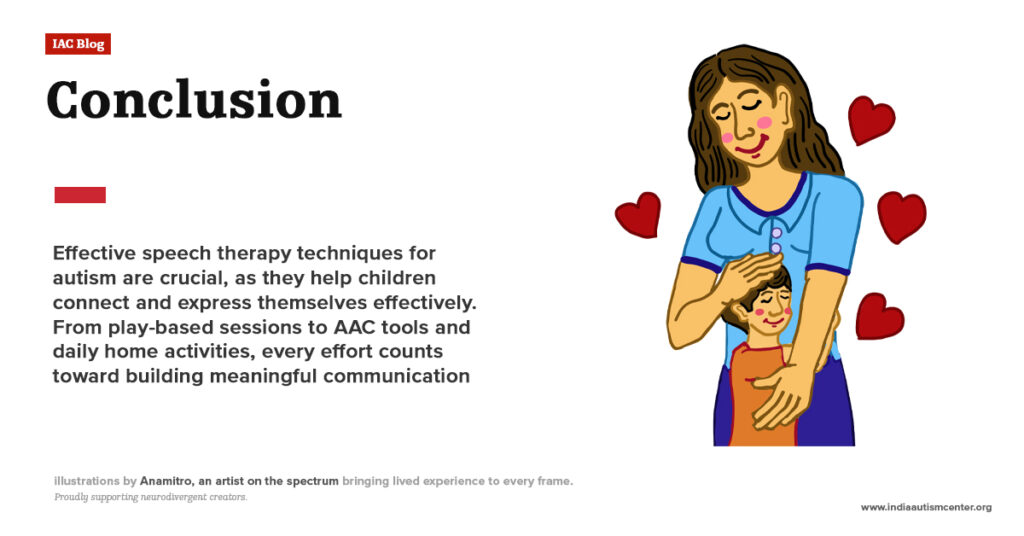
Effective speech therapy techniques for autism are crucial, as they help children connect and express themselves effectively. From play-based sessions to AAC tools and daily home activities, every effort counts toward building meaningful communication. For better results, it is essential to receive the proper guidance, maintain consistency, and have support. Speech therapy is known to empower children with autism to find their voice.
Frequently Asked Questions
How does speech therapy help kids with autism?
Speech therapy for autism focuses on improving verbal and nonverbal communication skills. It helps children understand language, express their needs, and interact meaningfully with others in daily life.
At what age should speech therapy start for a child with autism?
Experts recommend starting speech therapy for autism as early as possible, ideally between ages 2 and 5, when language development is most active. Early intervention improves long-term communication outcomes.
How long does speech therapy for autism take to show results?
Progress varies by child, but consistent sessions combined with autism speech therapy activities at home can show noticeable improvement within a few months.
How do parents support speech therapy at home?
Parents can reinforce therapy goals by using short, repetitive phrases, encouraging turn-taking, and incorporating speech therapy activities for autism into daily routines, such as meals or playtime.
What are some visual supports used in autism speech therapy?
Visual supports, such as PECS cards, picture schedules, and flashcards, help children associate words with images, making communication more straightforward to understand and comprehend.
For expert insights, support services, and inclusive learning initiatives, visit the India Autism Center.

